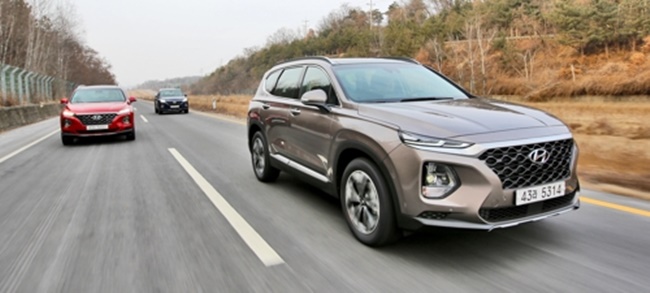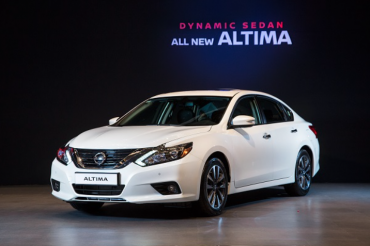
This photo taken on Feb. 21, 2018 shows the all-new Santa Fe SUVs running on a motorway near Seoul in a media test drive event. (Image: Hyundai Motor Co.)
ILSAN/PAJU, South Korea, Feb. 21 (Korea Bizwire) – Hyundai Motor Co.’s all-new Santa Fe sport-utility vehicle showed off its superior value proposition on the roads near Seoul ahead of its planned launches in global markets, starting with the United States this summer.
In the 100 minutes-long 120 kilometer course through the towns of Ilsan and Paju, just northwest of the capital city, the fully-revamped Santa Fe, equipped with a 2.0 diesel-powered engine and an eight-speed automatic transmission, performed faultlessly.
At low speeds of less than 60 kilometers per hour, the midsized family SUV offered a very quiet ride compared to other crossovers in its class, with little wind and road noise entering the cabin despite the chunky 19-inch wheels, which are one inch bigger than those on regular trim Santa Fe models.
Once the car entered a motorway, the all-wheel-drive SUV model was powerful enough to effortlessly reach speeds of up to 160 km in seconds from 90 km. But at higher speeds there was a bit of wind noise and the sound of the diesel engine at higher revs could be heard.
Despite the height of the body, cornering was composed and stable but there was some lean, as can be expected with the higher center of gravity. Braking performance was not like those of sports cars but the system responded firmly when the brake pedal was pressed.
The new car recorded fuel efficiency of 12 km in the test drive at an average speed of 100 km/hr.Besides solid driving characteristics, the fourth-generation Santa Fe carries advanced technologies that include driver assistance systems and a set of safety features, such as safe exit assist (SEA), rear occupant alert (ROA) and rear cross-traffic collision avoidance assist systems.
The SEA and ROA technologies have been developed by the Korean carmaker and are the first of their kind to be introduced in a car anywhere in the world.
The SEA makes an alarm sound when a passenger departs from the vehicle if a car is approaching from behind. The ROA alerts the driver if a passenger is in the rear seat, a feature designed to prevent parents from accidentally leaving children in a car that might become dangerously hot inside.
In the U.S. market, where demand for SUVs is growing, Hyundai is expected to promote those features to differentiate the Santa Fe from rivals such as Peugeot 5008 and Volkswagen’s Tiguan Allspace. The U.S. model will have a 2.0 turbo gasoline engine, with a 2.2 diesel engine being an option in other markets.
Given the advanced features that also include a head-up display, the first of its kind for Hyundai SUVs, the new Santa Fe carries a reasonable price tag in the domestic market. The prices start at 29 million won (US$27,000) and rise to 37 million won for a fully optioned car.
In South Korea, Hyundai aims to sell 90,000 Santa Fes in 2018. The model to be sold in the U.S. will be gasoline-powered and Hyundai’s overall sales this year will be affected by the sale of the new model in the world’s most important automobile market.
Hyundai said that on top of an extended length and width, the new Santa Fe comes with a completely restyled exterior design compared to its previous model.
The new SUV looks a lot more streamlined and premium than its predecessor. It carries split head-lamps and a wide cascading grille and the side profile of the new model flaunts simple character lines, making it look clean and angular.
A look inside the car shows simplicity in the dashboard layout with a set of easy-to-read buttons for radio, navigation, and air conditioning systems. But the positioning of the air conditioning vents was awkward since they are placed just below the eight-inch navigation screen and above other essential buttons.
(Yonhap)






